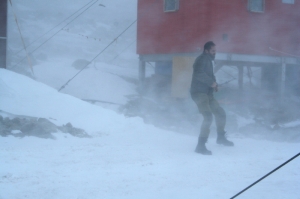Did you know that when you run out of things to talk about, you talk about the weather?
The weather changes dramatically as you move from the inland to the coast of Antarctica, rather like what you see in Norway, but more extreme.
 Storm at the Norwegian Polar Institute’s Troll station. Director Jan-Gunnar Winther is seen moving outside the station in strong storm conditions (wind speed 11) in 2007. Photo: Stein Tronstad / Norwegian Polar Institute
Storm at the Norwegian Polar Institute’s Troll station. Director Jan-Gunnar Winther is seen moving outside the station in strong storm conditions (wind speed 11) in 2007. Photo: Stein Tronstad / Norwegian Polar Institute
The temperature in Antarctica is generally exceedingly low. Several factors contribute to this, including the low solar radiation in the winter, the ability of ice to reflect sunlight, the cooling effect of long wave radiation from the continent, and the high elevation. The average temperature ranges from about -60°C at high elevations (-70°C in the winter and -40°C in the summer) to around -10°C near the coast (-25°C in the winter and -2°C in the summer) In 1983 a temperature of -89.6°C was registered at the Soviet station Vostok in West Antarctica. That is the lowest temperature ever measured anyplace on Earth. The low temperatures in combination with dry air mean that people who work outdoors struggle with dry skin and cracks in their skin and lips if they are not careful.
Most of the precipitation in Antarctica falls during the storm cycles that are characteristic of the coastal areas in the winter. These areas often receive 150 to over 600 mm of precipitation in the form of snow during a year, whereas precipitation in excess of 50 mm per year is rare in the inland. For comparison, it snows approximately 500 mm per year in Tromsø and 150 mm per year in Oslo. To convert mm of precipitation to metres of snow, assume that the amount of snow is about three times that of precipitation. By using this formula we can calculat that about 2 metres of snow fall in coastal Antarctica.
Gravity forces the cold, heavy air lying above the continent down towards the coast. The resulting winds at the coast can have a velocity of up to 90 m/s (320 km/h). At the South Pole, the wind is seldom stronger than 9 m/s (30 km/h).